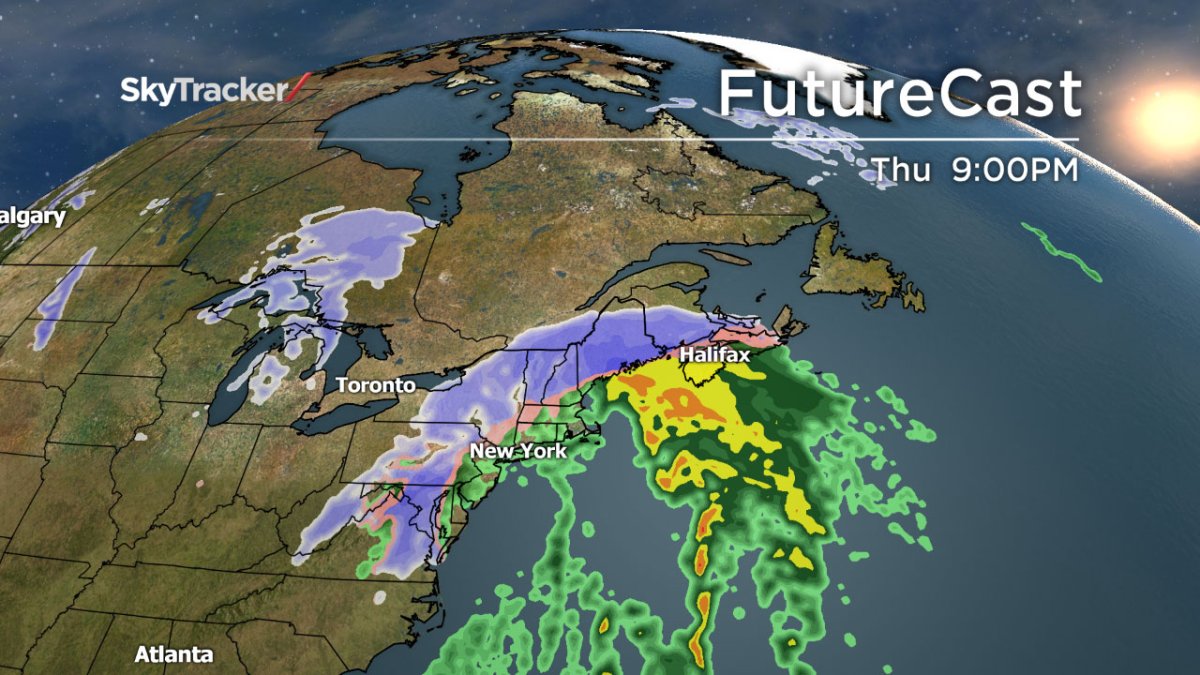Video: A wicked ice and snow storm has hit the southeast U.S. and it’s paralyzing places unaccustomed to dealing with such wintry chaos. Robin Stickley reports.

TORONTO – The winter storm that caused havoc in the United States’ Deep South on Wednesday is setting its sights on the country’s east coast and will eventually moving into Atlantic Canada.
“We’ve got a jet stream that’s moving across the Gulf of Mexico, and it’s spun up a low pressure system…and that’s providing the moisture,” Kurt VanSpeybroeck, Emergency Response Meteorologist with the National Weather Service (NWS) told Global News. “The cold air has come down and is in place from earlier this week, and that all mixing together is what’s causing this very large, snow and ice and sleet field all across the south. Eventually it will turn into a snowstorm, a nor’easter going up the mid-Atlantic going up the east coast of the United States.”
VanSpeybroeck said that it’s not totally unusual for the south to get this kind of strong storm. The region had similar storms in 1993, 2000, and 2003.
“It’s rare, but it’s not super rare,” he said. “We would see this maybe every five to 10 years in certain locations.”
READ MORE: In photos: Snowstorm cripples southern U.S.
- ‘Alarming trend’ of more international students claiming asylum: minister
- Justin Trudeau headed to UN Summit of the Future amid international instability
- Canadian government’s satellite deal has Tories calling for Elon Musk involvement
- Activists call for Boogie the monkey to be removed from Ontario roadside zoo
A nor’easter is a powerful low pressure system that is named not for the direction in which it travels, but rather the direction from which the wind blows. These storms are winter’s most powerful, causing blizzards, rain, or a mix of precipitation. Many times – as in this case – the storm forms as far south as the Gulf of Mexico and draws up moisture as it heads toward the north Atlantic. It mixes with the cold air from the north and is carried up by the jet stream.

Get breaking National news
The NWS has issued a winter storm warning, ice storm warning or a winter weather advisory for a large portion of the eastern U.S. — that’s for about 90 to 95 million people.
“That’s about a third of the population of our country,” said VanSpeybroeck.
The storm is moving up the northeastern seaboard and will affect eastern Canada by late Thursday. Environment Canada has already issued a special weather statement for parts of Quebec, New Brunswick, and Nova Scotia. Rainfall and wind warnings have been issued for parts of Nova Scotia ahead of the storm.
“As it moves up the east coast and starts to pick up energy maybe from the Gulf Stream…there’ll be some heat and energy it can tap into, and it may become stronger and be more intense along the mid-Atlantic states,” VanSpeybroeck said.
Already, 20 to 25 cm of snow is being forecast for Virginia and Washington, D.C.; New York and New Jersey also have significant winter storm warnings. Thursday’s air travel into or out of the eastern U.S. will likely be severely affected.
The good news is that so far, the storm isn’t as bad as the weather service had forecast. They believed that with the snow and ice that power outages would likely affect 300,000 to 500,000 people. Right now only about 120,000 are without power.
But the weather service likely used its strong wording for its winter storm warning — “catastrophic,” for example — in order to ensure that the public took the warning seriously.
“You can repair houses, you can get new cars, but when you put your life in danger, that’s a whole different story,” VanSpeybroeck said.
This is the second winter storm the southern U.S. has seen in the past two weeks. Can they be linked to climate change?
“It’s very, very hard to link climate issues and climate patterns to actual weather,” VanSpeybroeck said. “Weather is a very small time and space scale and climate is really based on a much larger timescale and larger global patterns. It’s really hard to take one instance and say, ‘This is a sign that these two things are linked and one is causing the other.’ It’s just too hard to tell.”






Comments